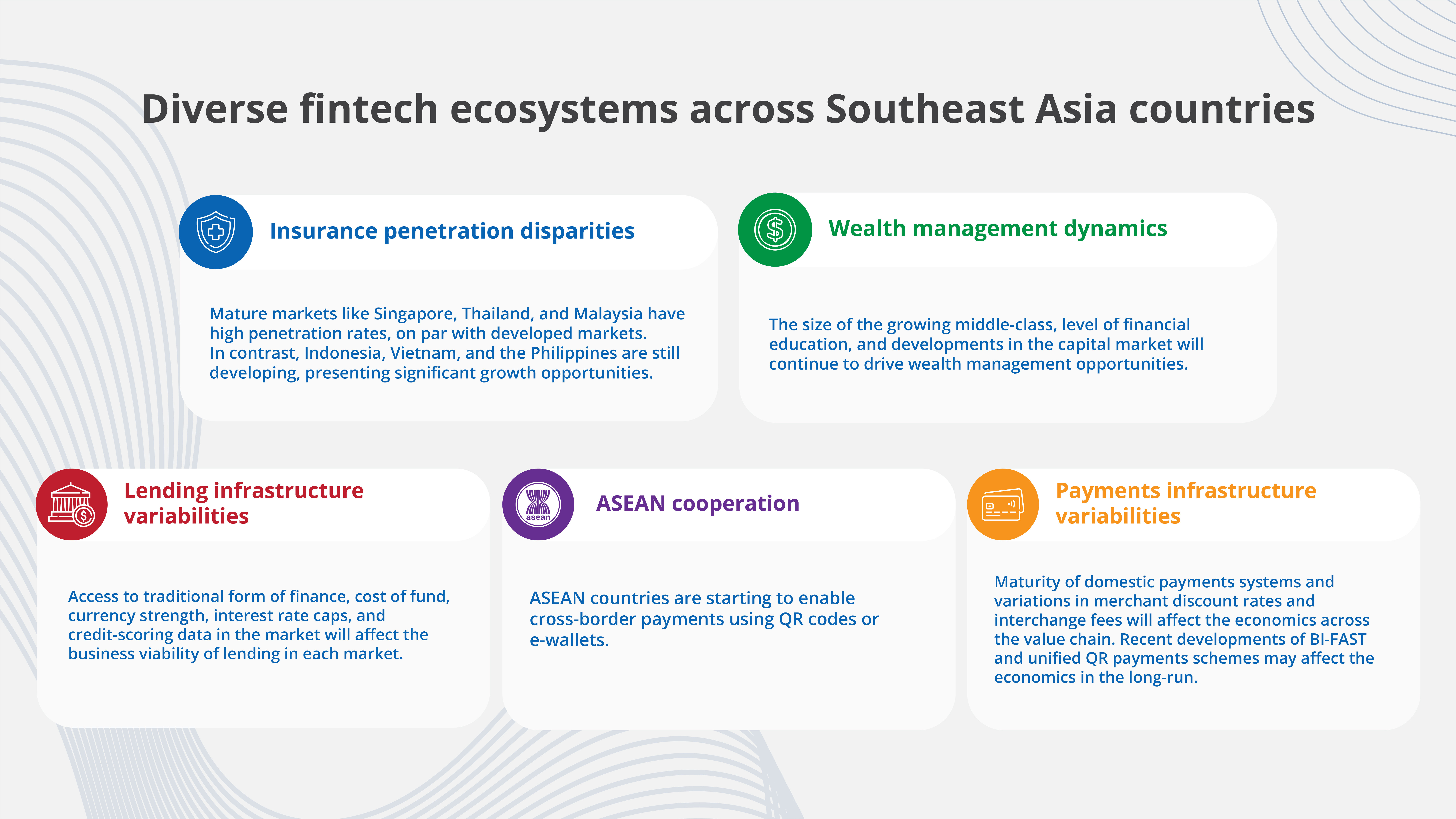Indonesia’s fintech sector has undergone dynamic evolution, beginning with innovations in online payments and diversifying into different vertical industries, reaching the untapped markets in tier 2 and tier 3 cities, and addressing the unique financial needs of other startups in the ecosystem. This evolution highlights the adaptability and diverse innovations within Indonesia’s fintech landscape.
The fintech journey in Indonesia began with a focus on facilitating online payments responding to the rise of online transactions and tech companies. Pioneers like Xendit, one of East Ventures’ portfolio companies in fintech, significantly helped refine payment flows and provided payment infrastructure for tech companies locally and regionally.
As part of the evolution to digitize cash transactions, several players started offering e-money in e-wallets, including GoTo’s GoPay and other players. Some have tried aggregating payment terminals in offline stores into one single terminal or providing mobile POS products like Moka, backed by East Ventures and acquired by Gojek in 2020, as a cheaper alternative to traditional POS systems.
The presence of fintech platforms also accelerates financial inclusion into tier 2 and 3 cities, previously untouched by non-cash payment infrastructure. For instance, Kudo targeted this space, offering innovative solutions to these untapped markets. Kudo was acquired by Grab in 2017.
Following the journey from the beginning, we see Indonesia’s fintech development embarked on several milestones, as we describe below.
Rise of fintech lending platforms for consumers
With over 50% of the adult population in Indonesia being unbanked or underbanked, fintech lending platforms emerged as a solution, fulfilling the gap. One of these platforms is Julo, which focuses on providing consumer loans while utilizing alternative credit scoring. Julo provides two primary arms of the business. First, direct-to-consumer, where customers can install Julo’s app and use a virtual credit line to transact. Second, business-to-business-to-consumer (B2B2C), enables other companies to leverage Julo’s expertise in providing lending services, from credit scoring, underwriting, loan management system, funding, and more.
Transition to digital banking solutions for SMEs and Startups
The proportion of unbanked and underbanked small and medium-sized enterprises (SMEs) are similarly large. Lending startups have evolved their business models from simple peer-to-peer models to digital banking plays, often achieved by acquiring banks, or securing Payment Service Provider (PJP) licenses in Indonesia.
Startups in this sector are also diversifying by specializing in different niches. For instance, Komunal focuses on serving rural banks (BPR) across Indonesia, currently working with more than 15% of BPRs in the country. Hijra Bank (previously known as ALAMI) caters to the Islamic finance sector. A number of players offer early-wage-access lending schemes to employees. Some are also offering embedded finance solutions to enable non-fintech companies to provide some form of lending product.
Moreover, companies outside the fintech sector, having established substantial customer bases, are exploring opportunities in lending. For instance, tech players in automobile space typically offer asset-backed lending schemes. These diversification and specialization illustrate the dynamic evolution of startups in response to market needs and opportunities.
Concurrently, some fintech startups recognize the need to cater to other startups’ and small to midsize businesses (SMBs)’ needs, including remittance services, cash flow management, and other financial processes in the company.
Seeing the potential, East Ventures invested in Jack (formerly Transfez), a platform addressing a crucial need for startups: expense management solutions, which include corporate credit cards, payroll, reimbursement, transfers, and more. Given startups’ limited financial history, securing corporate credit cards is often a struggle, making Jack’s solutions invaluable in easing and refining their financial processes.
The emergence of neobanks: pros and cons
While digital banks are typically online branches of established, traditional banks, neobanks operate exclusively online without offline or physical branches. Sometimes, they operate independently but some collaborate with traditional banks.
Although many neobanks are emerging today, the average deposits are still relatively smaller compared to traditional banks. Regulatory and compliance are other challenges – especially when these are not the first focus for an early-stage tech startup. The road might seem rocky, but neobanks might not just be a ‘fad,’ says Ringkas, a digital mortgage platform aiming to solve the access to financing problem for home seekers in Indonesia and Southeast Asia.
Wealth management and online stock trading
The sector also saw a surge in platforms centered on wealth management and online stock trading, tailored for the Millennial and Gen Z demographics. Companies like Stockbit, which offers the Stockbit app for e-trading and the Bibit app for robo-advisory products, gained significant traction, especially during the pandemic.
Developments in insurtech
The insurtech sector has seen extensive developments, with companies diversifying distribution models and delving deeper into the value chain. Following the global trends where markets typically initiate offline educational approaches to insurance products, Fuse has been the leader in the space by enabling insurance agents to scale. We are now observing ventures into underwriting and micro-insurance for e-commerce products in the market.
Reaching the unbanked in rural areas through BPR
A study by Fulcrum Singapore shows that Indonesia is facing a huge financial inclusion issue where only 23% are well-served in financial service needs, while 26% are underbanked, and a whopping 51% are without access even to basic financial services. This issue is then coupled with Indonesia’s low financial literacy rate, where many still make poor financial decisions, incur loans from irresponsible lenders, or get caught up in fraud or scams.
One of East Ventures-backed fintech platforms, Komunal, is focusing specifically on digitalizing rural banks (Bank Perekonomian Rakyat or BPR) and serving the underbanked population including tier 2 and 3 cities. This aligns with the company’s mission to accelerate financial inclusion and strengthen the digital rural bank ecosystem in Indonesia, especially outside the Greater Jakarta area, through DepositoBPR.
Rural banks have difficulty attracting deposits as BPRs are usually located in the suburban area hence they can only attract depositors within their proximity, despite the fact that the government guarantees ceiling rates of 2.5% higher than commercial banks. Additionally, most of these processes are also still traditional and fragmented. DepositoBPR aims to bridge this gap – it allows deposit transactions to easily be made online.
At the East Ventures Summit 2024, Hendry Lieviant, Co-Founder and CEO of Komunal told us more about what the company does and its impact on the underbanked. Watch the full session below.
Overarching challenges in the fintech sector
The horizon looks promising for the Indonesian fintech sector but has challenges. A significant short-to-medium-term concern is the rising cost of funds due to the prevailing high-interest rate environment and rising NPLs (non-performing loans) as credit is tightened in the market.
The rising cost of funds is putting pressure on fintech companies’ margins, with the average net margin decreasing from 10% in 2021 to 8% in 2022, as reported by McKinsey & Company.
To remain viable, fintech companies must innovate and adopt sustainable business models that ensure longevity while minimizing potential losses. One way is by reducing the cost of funds through access to customer deposits, although challenges remain in acquiring customers with the right economics and approach.
Other challenges include merchant discount rates that have been traditionally low relative to other adjacent markets, putting pressures on margins for payment companies serving in the space. As such, we observe the companies serving in the space to enter adjacent spaces, such as lending.
Diverse fintech ecosystems across Southeast Asia countries
Southeast Asia’s fintech ecosystem is diverse, with each sector carved by its unique market maturity, regulatory landscape, and consumer demands. It shows the advancements in insurance penetration, wealth management dynamics, and payment solutions. The diversity reflects the different opportunities and challenges, with innovations in payments and credit services altering the financial landscapes and creating unique competitive environments in each country.
A champion in regional expansion is Xendit, which started as an e-wallet with 160,000 users within four months and then pivoted to a payment gateway that processes about US$70 billion across Southeast Asia.
The key to winning Southeast Asia? Go hyperlocal, Xendit’s CEO and Co-Founder Moses Lo shared during the East Ventures Summit 2024 panel. Understanding the local regulators, big families that run the countries, and the business itself – including sales, marketing, and product – should be the main focus when entering a new market in the region.
Moses shared that, Xendit always “builds something that did not exist before,” even in the Philippines, Malaysia, Thailand, and Vietnam, enabling whole new digital economies to begin.
Watch the full session below to learn more about Xendit’s journey to becoming a regional unicorn.
Key takeaways for new founders in the fintech sector
1. Deep dive into industry intricacies
- The fintech sector is dynamic and multifaceted. New founders must invest time in understanding its nuances to make informed decisions.
2. Regulatory awareness is essential
- The fintech industry is heavily regulated, and each country has distinct regulations to adhere to.
- Familiarizing oneself with licensing roadmaps and the perspectives of regulators is essential.
3. Regulatory knowledge of multiple markets and response speed is crucial
- Beyond ensuring compliance, understanding regulatory developments in multiple markets can help founders anticipate challenges ahead.
- We have seen response time to regulatory changes determine the future paths of companies in the same space. Plan and execute ahead of your competitors where possible.
4. Closely monitor take rates in your business and plan well into the future
- Take rates in payments and acquiring businesses have decreased over time globally.
- The market is no longer convinced with high transaction volume or value with negligible take rates. The economics will need to be there.
5. Strategic long-term planning
- Given the evolving nature of take rates, founders should incorporate this potential risk in their mid to long-term strategies.
- Being proactive and adaptable is key to staying ahead in the game.
6. Geographical business model variations
- Successful fintech models in the U.S. and Europe may sometimes find different outcomes in Southeast Asia, often with timing (too early) and market size issues (too small).
7. SEA’s evolving landscape
- The Southeast Asian market is in a state of constant flux.
- Business models that may not be viable today could turn into lucrative opportunities in the future.
By Yoshiharu Okubo, Principal at East Ventures, and Gavin Adrian, Investment Professional at East Ventures.








